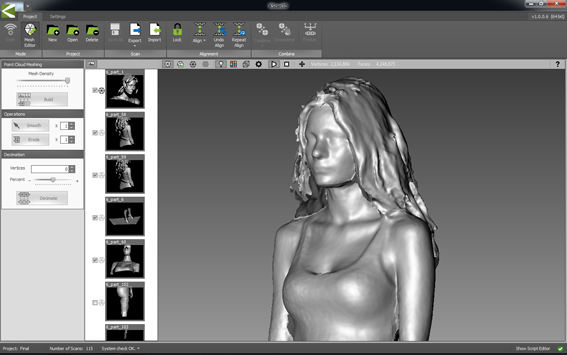3D3 Solutions releases ‘fully featured, easy to use 3D scanning solution’
LOS ANGELES – Here at Siggraph 2012, a show dedicated to computer graphics and interactive techniques, 3D3 Solutions released KScan3D, a software package that supports the Kinect as a 3D scanning device. For $299 (or free 14-day trial), users can now scan objects and locations with a Kinect and quickly get mesh models or point clouds, which can be exported in ASCII, OBJ, STL, PLY and 3D3’s proprietary format.
Nick Koziupa, product manager for KScan3D, said the software isn’t that much different from the company’s FlexScan3D software, which supports the company’s HDI 3D scanner. Thomas Tong, president of 3D3 Solutions, “saw an opportunity for using the Kinect for all kinds of 3D purposes,” Koziupa said. “It was a pretty logical move to take the four years of technology development of the FlexScan3D software and create KScan3D. We just stripped out all the stuff that wasn’t related to the Kinect.” Tack in the PrimeSense drivers and tinker with the UI, and there you have it.
You can see a demonstration of the product in the following video:
He said it only took about 12 weeks from concept to the final product they announced here at Siggraph.
But what can you really get from the Kinect? 3D3 isn’t trying to fool anyone. Even in its product press release, they say KScan3D will “provide beginners, students, educators, and hobbyists with a fully featured, easy to use 3D scanning solution.” This doesn’t equal their other professional-grade solutions. But neither are the prices equal.
“The resolution of the Kinect,” said Koziupa, “well, it’s kind of strange to say, but it is what it is. It’s a VGA kind of sensor. It’s not going to give you amazing data. But it’s going to allow your average user, your students, to get into this and capture stuff that will be clean enough to provide you with a model that you can then play with as you need to.”
For those just getting into 3D game design, or 3D animation, it’s a very accessible way to not have to start from scratch.
Plus, this is laying a path to the future. “We don’t have any inside information about the Kinect 2 or the XBox 720,” Koziupa said, “but I saw a screenshot floating around, and we’re obviously pretty excited about it. If it’s true, it would be a pretty considerable increase in resolution, and then you can imagine the kind of data you could get out of it. We want to make sure we’re on top of that when it’s released.”
The KScan3D solution is also incredibly mobile. Koziupa pointed out that he’s using a MacBook Air, weighing only three pounds, running Bootcamp, plus a Kinect plugged in via USB. You can basically take that anywhere. “The fact that it’s so mobile is a pretty big deal,” he said.
You can find the full hardware requirements here, but they’re not particularly onerous.
Of course, you’re limited by the limits of the Kinect. Its range is something like 16 inches to 13 feet, but as you get further from the Kinect device, the resolution begins to drop pretty quickly. “Get up as close as possible,” Koziupa said. “You can capture a significant amount of data for sure. And then you can decimate it if you want.” The sample model they have on their site, captured with KScan3D is part of a data set weighing roughly 80 MB.
The software supports 3D printing of objects, too. If you scan carefully with the Kinect, there is a hole-filling functionality that will allow the export of water-tight models appropriate for printing.
Finally, sophisticated users might be interested in the KScan3D API. “It’s a pretty flexible system,” Koziupa said, “if you just want to use our engine and wrap your own thing around it.”
“There are some really good products out there,” Koziupa said by way of summary, “but what we’re trying to bring to the table is four years of successful product, with an interface – all the way from the installation of the program, to the UI, to the export – where we’ve really tried to make it easy to use and comprehensive. And I think we’ve achieved that.”






